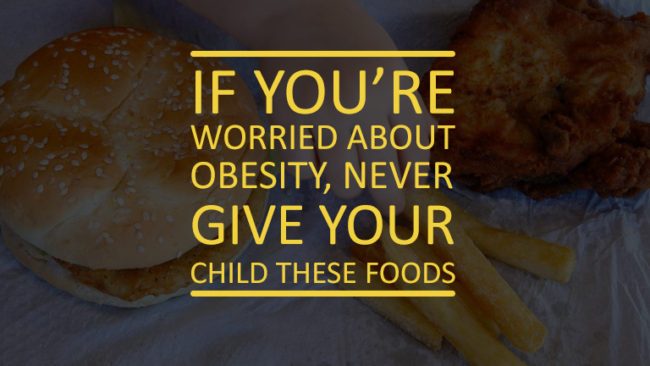
Alzheimer’s Update: What 2019 Has Revealed About the Disease
December 18, 2024
Cold vs. Allergies – What’s the difference?
December 18, 2024Childhood obesity is not only a widespread epidemic afflicting our nation’s youth, it is also creating a foundation for unhealthy eating and lifestyle habits with detrimental long-term outcomes for the health and physical well-being of both our children and the country as a whole. With our busy schedules and our kids’ endless after-school activities, often survival mode is all we can muster. And sometimes, despite our best intentions, that includes shortcuts in how we feed our children. Of course, as parents, we all want what’s best for our kids, but could we be the ones “feeding” this unhealthy and destructive lifestyle.

Believe it or not, the average American parent spends more on junk food than all other kid—entertainment expenses combined. Why? Well just look out the window as you drive to and from your various outings and what do we see? Convenience. Especially as it relates to food. Five dollar meals here, dollar menus there, 2-for-1 specials abound. In fact, it is cheaper and faster to stop by your trusted fast food establishment, order our children their “usual,” and let them eat it on the way home than it is to go to the grocery store, pick out a well-balanced organic meal, and take the time to both prepare and serve it.
Obesity is a real and present danger in our society, especially in the lives of our kids. While the health implications surrounding obesity are serious enough, the social problems endured by overweight children (who typically grow up to be overweight adults) because of their size and inactivity can be difficult to tolerate and often leading to increased incidences of childhood hazing, depression, and suicide.
If you are concerned about your kids maintaining a healthy weight (and you should be!) avoid these five foods like the plague. In doing so, you are taking the first step in giving your child the best possible chance of success in their physical and mental future:
- Processed Chicken Nuggets
These conveniently packaged edibles with powers to magically transform any child’s appetite through their unlimited irresistible shapes, sizes, and accompanying sauces are a staple on almost every menu. I mean what Chinese food menu would be complete without the kid’s chicken nuggets? Ironically, this forever present item is actually very low in real chicken meat and is instead filled with a medley of empty calories, fillers, preservatives, sugars and stabilizers. I don’t know about you, but yum is all that comes to mind.
While a delicacy to any two-year-old, a better option would be to make your own chicken nuggets at home. An easy milk-flour-breadcrumbs dip before baking (not frying!) can turn an ordinary chicken breasts into kid-approved and delicious! So, break out those stencils and come up with some creative shapes and your kid’s health will thank you for it.
- Unlimited M&M’s
After a change.org petition circulated the globe, the giant manufacturer of the popular candies finally answered. They admitted to using synthetic dyes linked to hyperactivity and other negative behavioral reactions in kids, and decided to ban those artificial dyes from their ingredients. Talk about aggressive marketing. Ever seen the sign, “Unaccompanied children will be given a handful of M&Ms and a free puppy!” Well now you know why.
It is wise to limit any “easy to eat” morsel that tempts you to eat more than one in a sitting. Remember the days when it used to be the chip company who took it a step further and challenged its consumers to see if they could only eat just one? Be your child’s advocate and limit these and other snacks and instead try a handful of almonds or other hard shelled nut for a healthier snack.
- Sugary and Diet Sodas
The sugar high your kids experience when drinking their favorite sodas won’t last long. In no time at all, they’ll be cranky, whiny and overly tired as they come down from their sugar rush. This will make it hard for them to focus in school and after school during homework time. Naturally, they won’t be the only ones feeling drained—so will you. With over nine teaspoons of sugar in the average soda, it’s no wonder why they are bouncing off the walls.
And even when we try and make it better, we can actually make things worse. Often, parents substitute their kid’s can of sugary soda for a diet one. However, there is significant danger in those as well. It is well known that aspartame, the most common artificial sweetener in diet soda, trigger the body’s insulin response with research demonstrating that diet sodas lead to an increase risk of what known as metabolic syndrome, or the overall reduction of one’s metabolism and resultant weight gain. If that weren’t bad enough, diet sodas have been shown to be responsible for a 67% greater risk of developing type 2, or adult onset, diabetes later in life with chronic use. Even other studies have shown that high levels of diet sodas can cause a degradation in the blood-brain barrier making it more difficult to recover from closed head injuries. Scary stuff, and all for a sugar fix.
Why not just teach your kids to stick to water instead? So, set a good example and dump out those sugary and diet sodas in the back of the fridge. Teach them the importance of cleansing from the inside out. Water is one of the greatest sources of life, after all!
- Packaged and Smoked Deli Meats
Steer clear from the hot dogs and bacon section. Those delicious-looking perfectly packaged meats aren’t very kind to your belly or your kids’ health. They’ll only help to put on the pounds and layers of fat, thanks to the enormous amount of saturated fats, oil and preservatives needed to keep them so tasty and fresh in your grocer’s refrigerated section. And while nitrates are often touted as the bad chemical in these products, nitrates occur naturally all around us. It’s the amount and concentration of nitrates in these products that lead to stomach and GI cancers in older patients after years of ingestion. The occasional hot dog is okay, just don’t make it a habit.
If your child doesn’t have any seafood allergies, try putting fish on this week’s menu for a healthy dose of nutritional natural oils and lean protein. Baked or grilled, fish is an excellent alternative to red meats and is recommended at least two to three times per week as your main dinner protein.
- Instant, Frozen Meals
While convenient and quick, these rectangular masterpieces of cuisine are loaded down with salts and preservatives because frozen environments have been shown to degrade the taste of food and spices. In their attempts to maintain that delicious Salisbury steak flavor or creamy triple mac n’ cheese delight, these frozen meals are often packed with unbelievable amounts of sodium (great for bloating!) and preservatives. In addition, food manufacturers purposely add more calories from starches and fats so that we feel more full after chowing down one of these meals in front while watching our favorite show. Of course, they want to make sure we feel we’ve gotten our money’s worth.
If time is an issue, toss those frozen meals in the trash and consider spending one day of the week cooking your kid’s favorite meal and pre-freeze or vacuum seal it for the week. Not only will you save time in the long run, but your kids will get to enjoy healthy home cooked meals without the added fats, salt and preservatives in these prepackaged store bought meals.
We know changing lifestyles can be challenging. So, start small and tackle one area you know you can improve upon. Agree with our list? Keep checking back on our blog for more healthy tips and life-saving advice for your family and little ones! Coming soon, the anti-inflammatory diet, does it really work?



